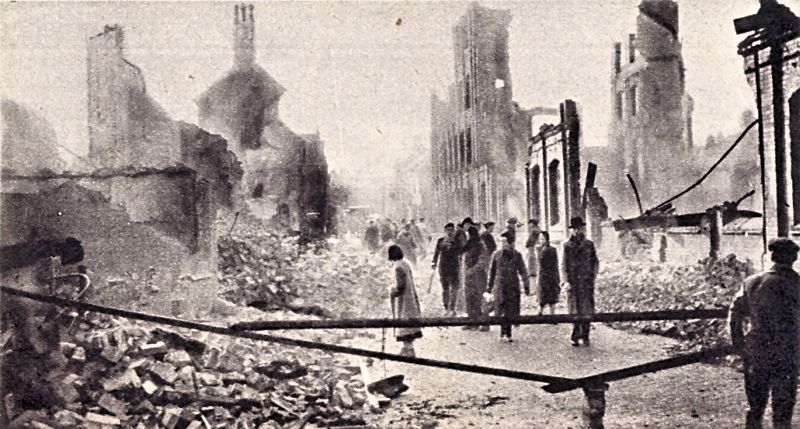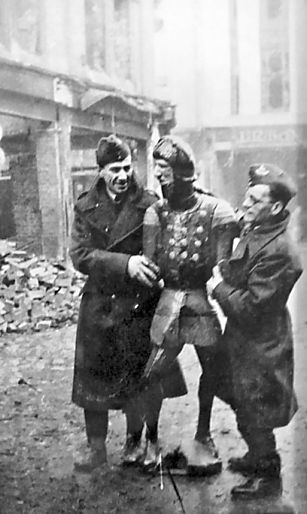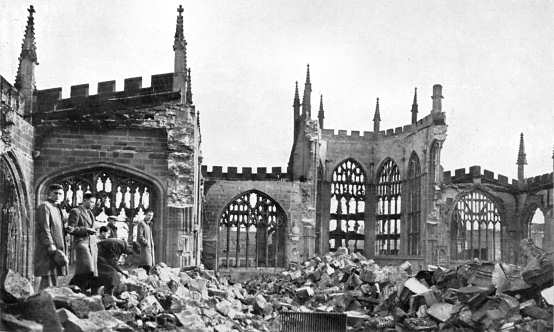Page 5
The raid begins

f the precise details of the forthcoming raid eluded the authorities, the people of Coventry knew even less, and were blissfully ignorant of what was about to be unleashed upon them. According to virtually all witness accounts, the morning of the 14th was just like any other, with no hint that anything 'special' was about to happen.

Broadgate after the raid. Try comparing this sad scene with the one on
this page.
The first warning locally that a raid was about to strike was just ten minutes before 7 o'clock when our anti-aircraft defence team were told that bombers were heading for Coventry. At 7:10 pm the siren sounded, and just as the sound of the siren died down, the first showers of incendiaries were already raining down from the pathfinding Heinkel 111's above. It was remarked by some that it was an early start that evening.... it was going to be a very late finish too!

Very little remained of Little Park Street by the 15th November. John Bailey Shelton, the father of Coventry's archaeology, lived in this street, and fortunately survived that night of terror. He had been determined to stay put that night, but as the houses and small factories in that street eventually formed one continuous raging inferno, the fire began to encroach on J.B.'s property where he also stabled five horses. By 1:30 am, he, with help from a neighbour, had to perilously lead the horses to safety through the flames - a selfless act for which he was later honoured with the RSPCA's Queen Victoria Medal. Although he managed to save some of his valuable books, several hundred other books, deeds, photographs and papers in his personal library perished in the fires that eventually engulfed his property.

In the background you can see the Burton's store, which stood until about a year after the war ended. If you wish to compare how it looked in January 1942 and in modern times, please try
this now and then page.
Despite the intense danger all around, some people still risked their lives to save some important relics of Coventry's past. This famous wooden staute of Peeping Tom was taken to safety from the soon to be destroyed King's Head Hotel, and can now be found on display upstairs in the Cathedral Lanes shopping centre, Broadgate.
Update May 2018: I've been very lucky to have heard from Ray Gordon, living in the States, who is a great-great nephew of Walter Gunn, the man on the right in this photograph. Ray also drew my attention to an excellent
video on YouTube, and if you cue it forward to around 46 seconds you will see these chaps in action with Peeping Tom.
 nce the first batch of incendiaries had fallen and started the fires to mark our doomed city, it was time for the high explosives to do their damage, creating a fire-storm and bringing down building after building. Of course, the fires spread even quicker due to the existence of so many of Coventry's ancient and closely built timber-framed buildings.
nce the first batch of incendiaries had fallen and started the fires to mark our doomed city, it was time for the high explosives to do their damage, creating a fire-storm and bringing down building after building. Of course, the fires spread even quicker due to the existence of so many of Coventry's ancient and closely built timber-framed buildings.
In earlier raids, many people had found the 18 inch long incendiaries relatively easy to deal with - a bucket of sand usually "doing the trick" before too much damage could be done. However, tonight the Germans were sending something even more fiendish.... exploding incendiaries. Purposely designed to catch people out, rather than allow easy quenching in sand, they would explode after a short delay, often badly injuring the person handling it. Fortunately, only a small proportion of the fire-bombs dropped were the exploding type.
The sheer number of these bombs, however, meant that there were far too many to be dealt with, and by 8 o'clock - only fifty minutes after the first bombs fell - the Central Fire Station had already recorded the outbreak of 240 fires. At that point the Station itself was hit, and they had to cease making detailed notes.
As the fires spread and increased in number, it seemed that nowhere could possibly escape destruction. Even in such dreadful circumstances though, people afterwards recollected many tales of a more light-hearted nature, including the sweet smell of tobacco smoke issuing from the burning newsagents, Salmon & Gluckstein, on the corner of Broadgate and High Street. Another lady recalled that a pig, hanging up in a butcher's shop, was "cooked to perfection"!

The raid affected everyone in different ways, and despite the loss of so many lives and properties, youngsters could still turn this into an adventure, evident here as some of them search amongst the rubble in the remains of the cathedral. It was towards 8 o'clock when incendiaries started to fall on the cathedral roof, and more photographs and information about this building, synonymous with Coventry's heritage, can be found on
this page.
 f the precise details of the forthcoming raid eluded the authorities, the people of Coventry knew even less, and were blissfully ignorant of what was about to be unleashed upon them. According to virtually all witness accounts, the morning of the 14th was just like any other, with no hint that anything 'special' was about to happen.
f the precise details of the forthcoming raid eluded the authorities, the people of Coventry knew even less, and were blissfully ignorant of what was about to be unleashed upon them. According to virtually all witness accounts, the morning of the 14th was just like any other, with no hint that anything 'special' was about to happen.


 nce the first batch of incendiaries had fallen and started the fires to mark our doomed city, it was time for the high explosives to do their damage, creating a fire-storm and bringing down building after building. Of course, the fires spread even quicker due to the existence of so many of Coventry's ancient and closely built timber-framed buildings.
nce the first batch of incendiaries had fallen and started the fires to mark our doomed city, it was time for the high explosives to do their damage, creating a fire-storm and bringing down building after building. Of course, the fires spread even quicker due to the existence of so many of Coventry's ancient and closely built timber-framed buildings.
